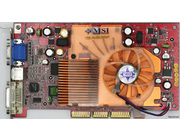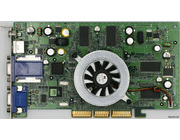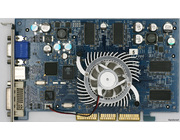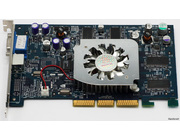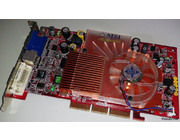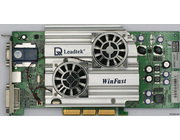MSI was one of the manufacturers that stood out back in the heyday of the GeForce 4 Ti. This card has a fairly decent cooler fitted and underneath the heatsinks you'll find 64MB of 3.6NS RAM. A lot of the Ti4200 cards only has 4NS RAM so MSI's card is in favor with overclockers. Add to that a temperature sensor as well and you'd be very happy in 2002 with this card ![]() .
.
The GeForce 4 Ti series launched with the models 4400 and 4600 that were only available with 128MB of memory. The Ti4200, that was launched a half year later, changed that. They were available in both 64MB and 128MB configurations. In a lot of situations the 64MB version was faster than the 128MB version because the 64MB cards usually had faster clocked RAM (250MHz/DDR500 instead of 2222MHz/DDR444, this MSI runs at 256MHz/DDR513). The extra video memory was rarely used, even with some of the newer titles. > Read more
Medion cards are built by MSI for use in Medion computers. Medion computers were sold by Aldi supermarkets and became fairly popular due competitive pricing. Medion didn't really cut back on features (in fact, they usually had good TV in/out and card reader options) but did differentiate slightly in clock frequencies. This particular card runs at GPU 225MHz and RAM 444MHz whereas a stock Ti4200 with AGP8x should run at GPU 250MHz and RAM 500MHz.
Despite the slower clocks the cards performed very well and could be considered high-end back in the day. > Read more
Another Ti4200 in the mix! It looks like a fairly ordinary Ti4200 but unfortunately there is one caveat. Take a look at the RAM chips and find out that they are rated 5NS. That means a mere 200MHz (DDR400) for this card. Standard Ti4200's run at 222MHz (DDR444) and 64MB models even go to 250MHz (DDR500) and beyond. Due to the low rated RAM chances of overclocking are slim, too.
The card still works fine however but back in the day one would've been happier with a 64MB MSI Ti4200-TD8X for example ![]() . > Read more
. > Read more
A GeForce 4 Ti with a nice shiny cooling solution. Something that was unique about XFX in these days: they wanted to differentiate with, for it's time, a somewhat fancy cooling design. They weren't the only one though as MSI usually had pretty good cooling solutions and ABIT had an oddball cooling solution they named OTES; a precursor to nVidia stock GeForce FX 5800 Ultra cooling that forced warm air outside the case.
This particular GeForce 4 Ti4200 is equipped with 64MB of 4NS DDR RAM. The RAM of 64MB versions are clocked slightly higher than the 128MB versions which makes the 64MB version often the faster card. Check out the benchmarks of the MSI Ti4200 -TD8X that is configured identical to this XFX. > Read more
The GeForce 4 Ti was released in 2002 and readily available in mid-2002. A lot of companies brought out versions of the Ti4200 with different cooling designs and game/software packages.
MSI's version has a fairly decent cooling solution with a decent heatsink and cooling of the RAM chips on both sides of the card. A lot of cards had cooling solutions that didn't have headroom left. > Read more
Leadtek's WinFast A280 is based on the nVidia GeForce 4 Ti4800-SE chip. This is an AGP8x version of the GeForce 4 Ti4400. Somehow the names of the GeForce 4 Ti aren't as expected. The first AGP4x cards were 4200, 4400 and 4600 and their AGP8x versions are 4200-8x, 4800SE and 4800. In my opinion nVidia should've continued with the -8x suffix and sold 4400-8x and 4600-8x's instead. > Read more
